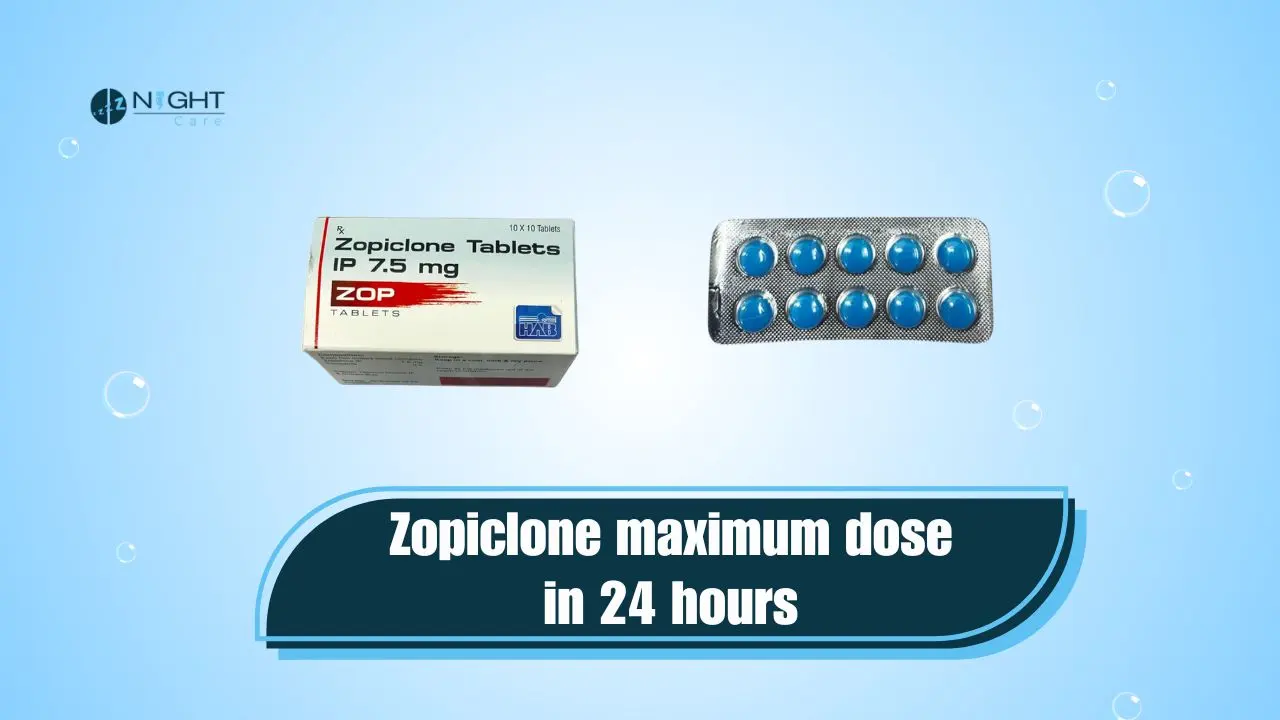If you’ve been prescribed zopiclone for short-term insomnia, understanding its safe dosage and the risks of exceeding the maximum daily dose is crucial for both effectiveness and safety. This article provides up-to-date, evidence-based information on the maximum dose of zopiclone in 24 hours, as well as dosing recommendations, considerations for special populations, signs of overdose, and tips for responsible use.
Contents
What Is Zopiclone?
Zopiclone is a prescription-only hypnotic medication used for the short-term treatment of insomnia. It helps you fall asleep more quickly and prevents frequent nighttime awakenings. Zopiclone is generally recommended for single, occasional use or for a few nights in sequence to avoid dependency and loss of efficacy over time[1][2].
Zopiclone Dosage Forms and Dosing Guidelines
- Tablets: Available in 3.75mg and 7.5mg strengths.
- When to Take: Just before bedtime, ensuring you have at least 7–8 hours to sleep[1][3].
Standard Adult Dosage
- Typical Dose: 7.5mg taken orally once nightly before bedtime[1][4][3].
- Maximum Dose in 24 Hours: 7.5mg (Do not exceed this amount) [1][5].
Important: Zopiclone should not be taken more than once per night. Taking more than 7.5mg in a 24-hour period increases risk of severe side effects, dependency, and overdose[1][4][3][5].
Also Read: How Many Zopiclone 7.5 mg Tablets Can I Take?
Elderly Patients (Over 65 Years) and Special Populations
- Starting Dose: 3.75mg at bedtime[1][4][3].
- The dose may be increased to 7.5mg only if well tolerated and if the lower dose is not effective[1][4][5].
- Adjustments are also necessary for those with liver or kidney impairment, who should usually not exceed 3.75mg–5mg per night[4][6][5].
Children and Adolescents
Why Is There a Maximum Dose?
- Increased Risk: Doses above 7.5mg do not provide increased therapeutic benefit but sharply raise the risk of side effects such as confusion, excessive drowsiness, falls, memory problems, and respiratory depression[7][5].
- Dependency: Prolonged or excessive use may lead to dependence and withdrawal symptoms, especially if stopped abruptly[2][5].
- Overdose Danger: Even a slight overdose can cause central nervous system depression (severe drowsiness, loss of consciousness, breathing difficulty), with life-threatening outcomes at very high doses or when combined with alcohol or other sedatives[8][9].
Overdose Symptoms: What to Watch For
Overdosing on zopiclone can cause:
- Excessive drowsiness, confusion, or lethargy
- Loss of coordination, slurred speech, or ataxia
- Breathing difficulties, respiratory depression, or even coma
- Rarely, severe reactions such as methemoglobinemia, which affects blood oxygen transport[8][5][9]
If you suspect an overdose, seek emergency medical attention immediately.
Safe Use Tips
- Never exceed the prescribed dosage. If your insomnia persists, consult your doctor rather than increasing the dose on your own[1][4].
- Don’t combine zopiclone with alcohol or other sedatives. This greatly increases the risk of dangerous side effects.
- Take only when needed. Try to use zopiclone as infrequently as possible, and always combine with good sleep hygiene practices for best results[2][10].
- Short-term use only. Zopiclone is intended for use no more than 2–4 weeks at a time to minimize dependency risks[1][2].
Also Read: How Zopiclone Works: A Complete Guide to Better Sleep
Frequently Asked Questions
A: No. You should never retake zopiclone in the same night, even if you cannot sleep. This increases the risk of excessive sedation and dangerous side effects[11].
A: More is not safer or better—consult your doctor for alternative approaches if zopiclone isn’t effective.
The Bottom Line
- The maximum dose of zopiclone for most adults is 7.5mg in 24 hours. NEVER exceed this limit—even if you feel your sleep remains poor.
- Elderly or those with liver/kidney problems should start with 3.75mg.
- Never self-adjust your dose: always follow your health provider’s instructions for the safest outcome.
If you have concerns about your sleep or your medication, discuss them with your doctor—never adjust your dose independently.
Disclaimer: This article provides general information for educational purposes. Always consult your doctor or pharmacist for personalized advice.
References:
- https://www.nhs.uk/medicines/zopiclone/how-and-when-to-take-zopiclone/
- https://www.medsafe.govt.nz/profs/PUArticles/June2019/Zopiclone-Indicated-for-short-term-use-only.htm
- https://www.mims.com/singapore/drug/info/apo-zopiclone?type=full
- https://www.medicines.org.uk/emc/product/10590/smpc
- https://www.medsafe.govt.nz/profs/datasheet/z/zopicloneactavistab.pdf
- https://hpr-rps.hres.ca/details.php?drugproductid=3986&query=
- https://pubmed.ncbi.nlm.nih.gov/2201721/
- https://pmc.ncbi.nlm.nih.gov/articles/PMC10943492/
- https://en.wikipedia.org/wiki/Zopiclone
- https://healthify.nz/medicines-a-z/z/zopiclone
- https://www.nps.org.au/medicine-finder/zopiclone-gh-tablets
- https://nhssomerset.nhs.uk/news/document/zopiclone-tapering-document-june-2022/
- https://www.drugs.com/zopiclone.html


